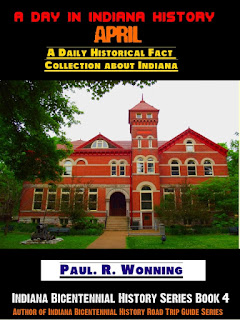 | |
| A Day in Indiana History - April |
The forested hills of south central Indiana
were never ideal farmland. They did contain some of the world's finest
hardwoods. The development of the steam powered sawmill in the middle of the
Nineteenth Century allowed large-scale timber cutting. Sawmill operators
cleared the hills of the trees, and then sold the land to farmers. Eventually
the farmers abandoned the land. The Hoosier
National Forest
The Knobs
A geologic feature called the Knobstone Escarpment dominates
south central Indiana . The knobs
include some of Indiana 's most
rugged terrain. It stretches from Brown
County State Park Ohio River . Elevations range from
360 feet near the mouth of the Wabash
River Brown
County State Park Indiana .
These steep hills also contained some of the world’s finest hardwoods. When the
steam powered sawmills came into use, loggers set to work.
Steam Powered
Sawmills
Prior to steam powered mills, sawing lumber was a labor-intensive
affair. If suitable waterpower was available water powered mills could cut logs
into lumber. A water powered sawmill still operates at Spring
Mill State Park during the summer months. Other sawing methods included the
pit saw. To cut lumber with a pit saw, the sawyers first hewed a log square
with a broad axe, and then placed the hewn log over a pit. Two men then sawed
planks from the hewn log using a crosscut saw. One man stood in the pit pulling
the saw down while another man stood on top, pulling the saw up. The men used a
chalked line as a guide to keep the plank to the desired thickness. Portable
steam powered sawmills came into use during the middle part of the Eighteenth
Century. These saws could use the waste wood as fuel to fire the boiler that
powered the saw. With the advent of these saws, loggers could, and did, log
vast quantities of timber.
Clearing the Land
By 1860, loggers had begun the work of converting the trees
to lumber. Thousands of sawmills operated in southern Indiana
and by 1900 the state led the nation in lumber production. Loggers first cut
the best hardwoods. These were walnut, oak, black cherry and tulip poplar. In
the next step, the logger cut the less desirable species, and then burned the
land off to finish clearing it. Cleared land sold for about a dollar an acre.
Farmers bought this land to farm.
Farming, then Abandonment
However, the steep hills were not suitable for farming. Then
crop prices dropped. The farm population in south central Indiana
peaked around 1890 then began a slow, steady decline. The Great Depression in
1929 finished most of the remaining farmers off. Many simply just walked away
from the land. Rains began eroding the cleared hills. Counties could not
collect taxes on the abandoned land.
The Hoosier National Forest
Indiana Governor Paul McNutt and the Indiana General
Assembly stepped in to try to salvage something from what had become an
environmental and economic disaster. On April
6, 1934 they passed:
"An Act to empower the United States of America to
acquire lands in the State of Indiana by purchase or otherwise, for
establishing, consolidating, and extending national forests, and to grant to
the United States all rights necessary for proper control and administration of
lands so acquired, and legalizing certain acts and proceedings connected
therewith."
Thus, the Hoosier National
Forest Indiana
we see today.
|
Follow @MossyFeetBooks
Tweet |
Visit Mossy Feet Books's profile on Pinterest. |
Back to Top
Comments
Post a Comment